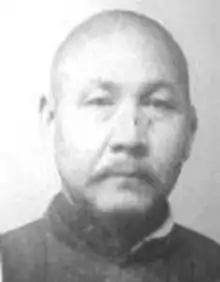Zhang Qinlin
Zhang Qinlin (1888–1967) was an influential martial artist, teacher, and lineage holder of the Yangjia Michuan style of tai chi. In 1929, Zhang won the All China Fighting Championship in the unarmed division.[1]
| Zhang Qinlin 張欽霖 | |
|---|---|
 | |
| Born | 1888 Xingtai, Hebei, China |
| Died | 1967 (aged 78–79) |
| Nationality | Chinese |
| Style | Yangjia Michuan tai chi |
| Zhang Qinlin | |||||||
|---|---|---|---|---|---|---|---|
| Chinese | 張欽霖 | ||||||
| |||||||
Early life and training
Zhang was born in Xingtai County, Hebei province, China in 1888, the son of a poor family.[2] After his parents died while he was still young, Zhang ventured out at the age of 14 to find a martial arts teacher. He eventually sought out the nearby Yang family household to learn Yang-style tai chi. There he began his martial arts studies with Yang Chengfu[3] under the supervision of his father, Yang Jianhou. During the initial years of Zhang’s training with Chengfu, he was only taught the publicly known elements of the Yang style disseminated to students outside the Yang family. After Zhang successful fought a challenge match against a famous martial artist from southern China, Wan Mou, the elder Yang decided the young student had earned the right to learn the Yangjia Michuan teachings. Thereafter, Jianhou had Zhang report to his personal quarters every night between the hours of 3 a.m. and 5 a.m. while the rest of the compound slept. It was then that Jianhou taught Zhang the Yangjia Michuan tai chi system in addition to his regular daily training.[4]
Competition and teaching
In 1929, the central Chinese government sponsored the All China Fighting Championship, a general competition in Chinese boxing. Each province was to send two participants – one for the armed division, one for the unarmed division—to Nanjing, the then capitol of China, to compete. Zhang, whose occupation as a fur merchant had required that he move to Shanxi in 1925, entered and won the regional competition for that province. According to the history provided by his student, Wang Yen-nien, Zhang went on to win the national championship in the unarmed division later that year.[5] However, there is no written record of Zhang having competed in any national tournament, let alone win one.
After Zhang moved to Shanxi, he began search for a student to whom he could pass on the Yang family teachings. In all, Zhang is known to have taught ten students, although only a subset of those was taught anything beyond the publicly known Yang style. Wang Yen-nien, who moved to Taipei, Taiwan in 1949 where he lived until his death in May 2008, was the second and last student of Zhang’s to receive the entirety of the Yangjia Michuan tai chi system.[6]
Tai chi lineage tree with Yang-style focus
References
- Rodell, Scott M. "Yang Family Taijiquan: The Hidden Tradition. Archived August 1, 2007, at the Wayback Machine" Inside Kungfu, Mar. 1993, pg. 45
- Wang, Yen-nien. "Yang Family Hidden Tradition of Taiji Quan, Illustrated and Explained." Vol. 1. Taipei, Taiwan: Hsin Hwa Publishing Co., Inc., 1988. pg. H-1.
- Yang, Chengfu. Taijiquan Yongfa Tujie, Taipei, Hua Lian Publishing Co., August, 1984 (original in spring, 1933), pg. 2
- Tomarchio, Sam. "Wang Yen-nien Talks about Zhang Qinlin. Archived October 22, 2008, at the Wayback Machine" AYMTA Journal, Volume 3, NO. 2, FALL 1995. Retrieved 11-1-2007.
- Wang, Yen-nien. "Yang Family Hidden Tradition of Taiji Quan, Illustrated and Explained." Vol. 1. Taipei, Taiwan: Hsin Hwa Publishing Co., Inc., 1988. pg. H-2.
- Wang, Yen-nien. "Yang Family Hidden Tradition of Taiji Quan, Illustrated and Explained." Vol. 2. Taipei, Taiwan: Hsin Hwa Publishing Co., Inc., 1997. pg. 37.